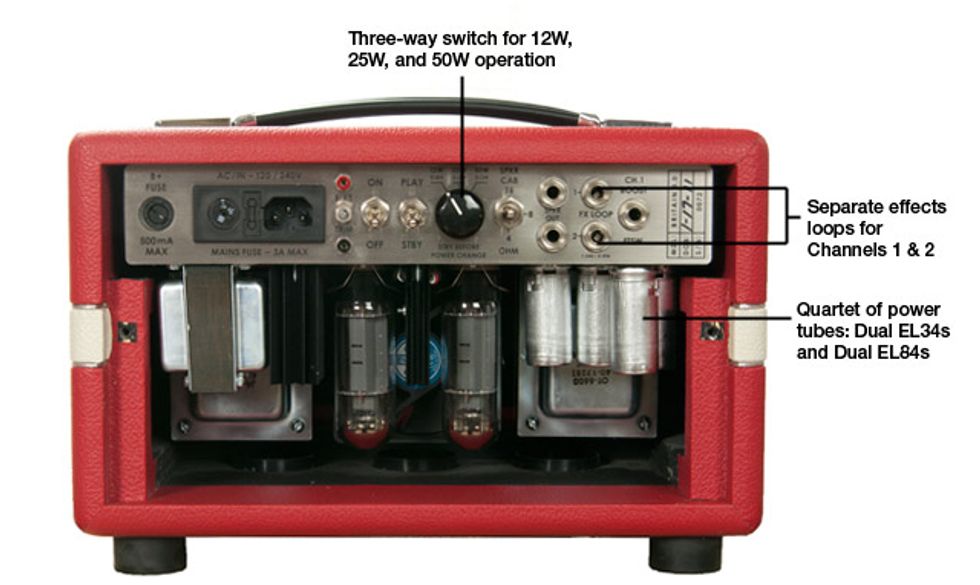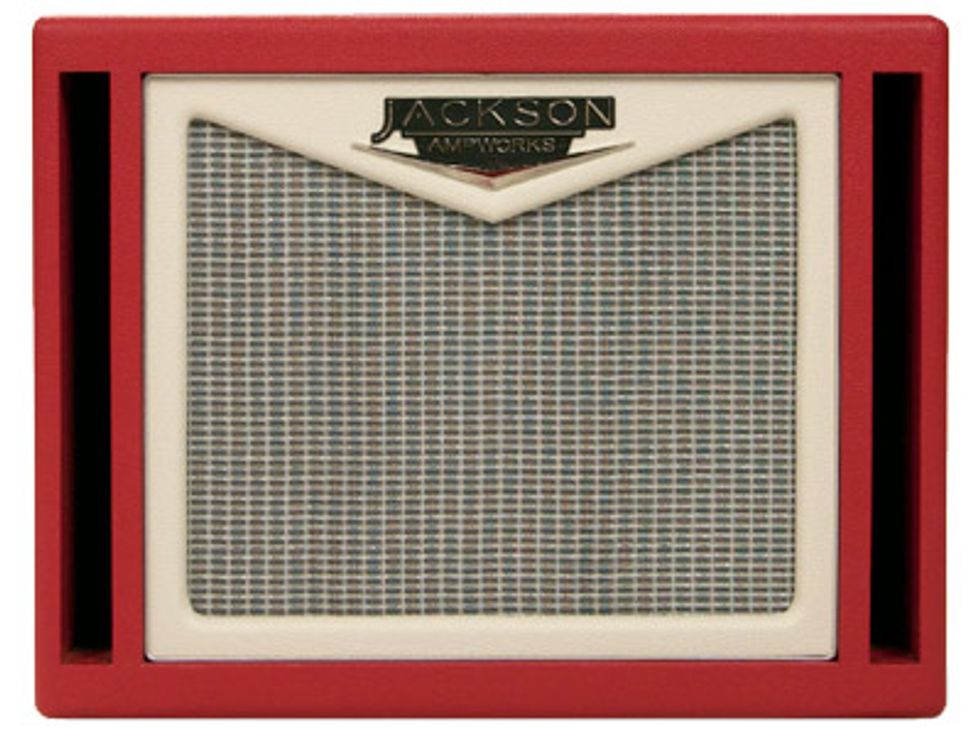| Download Example 1 12 Watt Class A mode with Les Paul, heavy crunch | |
| Download Example 2 25 Watt Class A mode with Hamer Korina Special | |
| Download Example 3 50 Watt Class A/B mode with Strat | |
| All clips recorded with a Chandler LTD1 mic pre into an Apogee Symphony I/O to Pro Tools HD9. SM57 off axis to 1x12 cab. Slight addition of Lexicon hall reverb in mix. | |
Stout and Potent
Weighing in right at 30 pounds, the 14”x 9.25” x 8.5” head is both sturdy and portable. And dressed up in deep red vinyl with a white “V” stripe surrounded by gold trim and a stainless steel faceplate, it pulls off looking simultaneously cute and badass. The front panel controls are packed pretty tight, but that translates to a lot of functionality for an amp of its size. From left to right, there are two inputs (1/2 and 2) followed by Channel 1 Volume, Treble and Bass, and Channel 2 Volume, Treble and Bass. An LED indicator above the tone knobs of channel one designates the switchable tone stack bypass and a jewel power indicator glows on the far right. The back panel is pretty packed too. Adjacent to the mains fuse and standard IEC power cable input you’ll find a Bias trim pot for external biasing then two toggles for power and standby followed by a 3- way knob that enables the switch between 12-, 25-, and 50-watt operation. A 16/8/4 ohm switch is located next to two speaker output jacks as well as two effects loops and the Channel 1 footswitch jack. It’s a testament to the Jackson team that they can pack this much functionality in such a compact amp.
Tubes consist of an EF86 preamp in Channel 1 and a 12AX7 in Channel 2. The four-tube output section contains a pair of EL84s and a pair of EL34s. When running in the Class-A 12-watt mode the power section utilizes the two cathode biased EL84s. In the 25-watt Class A mode it uses two cathode biased EL34s. And the 50-watt Class A/B mode uses the pair of fixed biased EL34s. There’s also tube rectifier emulation circuit that mimics a 5U4G rectifier in both the 12 and 25 watt Class A modes while a solid-state rectifier is used in the 50-watt Class A/B setting.

Installed in the amp to cool the tight chassis is a 4” high flow fan. All wiring is done with silver-plated Teflon hookup wire on a precision-cut aluminum chassis with ceramic tube sockets and rubber grommets to reduce vibration. F&T caps, Mallory 150 coupling caps, carbon comp and film caps as well as custom iron round out the component selection. Fit and finish on the head and cabinet is top notch. The vinyl covering is perfect and there wasn’t a flaw to be found. The cabinet is also a thing of beauty. Redesigned with a double baffle on the left and right side it offers the best of closed and open back design. The sturdy cab houses a Celestion Alnico Gold 8ohm speaker. And a handle on the top of the cab makes for easy and balanced carrying.
Jack of All Trades
Eager to fire up the Britain, I lined up a rack of guitars and flipped the power switch to warm up the amp. The first thing I noticed, however, was that the internal fan used to cool the head was quite loud. In a studio setting I tend to keep the head nearby and use the cabinet in another room, but the fan proved to be a little unnerving. That said, it’s an understandable trade off given the tight quarters inside the amp and proximity of all those tubes together. Nobody wants an amp fire, after all.
That quibble aside, the Britain is a surprisingly versatile amp. My first thought upon looking at the controls was that I would miss a presence and mid control. That concern was wiped away as I plugged into the 1/2 input, which bridges Channels 1 and 2. Just working with the Channel 1 controls and set in the EL84 power position the sound of the EF86 tube shone like a beacon of chiming light. The decidedly Vox-like sound was bright and present with a beautiful three-dimensional quality that had me banging out Beatle chords and Tom Petty riffs. There was a surprising amount of tonal variety on hand just through mixing the bass and treble controls—which also contributed significantly to the gain of the channel. The interactive combination of volume, treble, and bass was infinitely valuable. And I was able to tailor the amp to move from fairly clean to crunchy to singing lead tones with ease. Because there is no master volume the sound does get up to decent decibel levels fairly fast. But the bonus is the attack, clarity, and punch that only come from a wide-open circuit. This is an amp that will stand out in the mix and never get buried.
Adding in the Channel 2 controls thickened up the bottom end and filled out the mids nicely. There was no lack of presence and a ton of detail, which will find you paying attention to your technique. Nobody will get away with slop on this amp, but the abundance of nuance is worth it.
The difference between EL84 and EL34 mode wasn’t much in terms of volume, but substantial in terms of sound. The extra bite of the overdriven EL84 was replaced by a full, bold, and chunky tone with a ton of guts and drive. I found the EF86 tube to be less gainy in this position but definitely more focused and round. Again the controls added more or less gain depending on their position and the mix of Channels 1 and 2 added endless tonal options. Moving from P-90s to humbuckers beefed up the sound even further, and with both volumes dimed I was treated to a roaring lead sound that sustained until it sweetly howled into harmonic feedback. The amp responds to a light touches too, exhibiting a capacity for ultra wide dynamics that ranged all the way to heavy and chunky.
The decidedly Vox-like sound is
bright and present with a beautiful three-dimensional quality that had me
banging out Beatle chords and Tom Petty riffs.
Switching to the 50-watt mode opened up the headroom significantly and I was able to coax beautiful clean tones from both channels one and two. I liked this mode a lot because it also opened up the ability to push the front end differently with a variety of pedals. Whether I threw a Hartman Germanium Boost or a Creation Audio Labs Holy Fire into the front, the Britain took it all in stride and brought out rich and incredibly dynamic elements that only enhanced its already impressive fundamental tones. One bonus of the Britain I enjoyed was the footswitchable tone stack defeat on Channel 1. Stepping on the included footswitch I was able to bypass the tone stack and get straight wire gain with added dimension—a nice feature that added fire and cutting sizzle without being overly bright.
The Britain actually supports two full effects loops, one for each channel. It’s an interesting feature that I’m not used to seeing on amps of this size. And being able to put a time-based effect on Channel 2 and a modulation on Channel 1 was a real treat—enabling me to dial in different effects levels and textures just by playing with the volume controls. The loops are quiet and effective, and while I normally wouldn’t find myself adding this to my setup it’s great to know that the option is there and that it works flawlessly.

The beautiful sound of the 8-ohm Celestion Gold cab is noteworthy too. The porting on the left and right and design of the baffle lends volume and dimension. And though the cabinet is relatively small, the focus and width of the sound exceeded that of any 1x12 cab I have used in the past. The bass response was huge and if I closed my eyes I’d never have guessed it was a single 12” cabinet. It seemed to mix the bass-rich elements of an open back and high-mid oriented tones of closed back cabinets very effectively—creating a tone range tone at least as open and defined as my favorite Marshall Basketweave 4x12.
The Verdict
Aside from the fan noise issue there, is not enough I can say about the goodness of the new Britain 3.0. It isn’t the quietest operating amp, but in the end I found the richness and versatility in tone hard to beat. The construction is absolutely top notch and the power and focus at various power levels found me forgetting about my attenuator. It’s clear that the Britain would be equally at home in a club situation or recording studio. And you can take the sound from clean to crunch to aggressive with a dial of just a few knobs. My initial concerns for the lack of a presence and mid control were erased over the course of my time with the amp and the styling of the head and cab are nothing sort of world-class cool. Regardless of price or power, The Britain 3.0 is a fine amp indeed.
Buy if...
you want versatile British tone in a compact and robust package.
Skip if...
you need bedroom playing levels and silent operation.
Rating...
Street $2250 (Head), $750 (1x12) - Jackson Ampworks - jacksonampworks.com |







![Rig Rundown: Russian Circles’ Mike Sullivan [2025]](https://www.premierguitar.com/media-library/youtube.jpg?id=62303631&width=1245&height=700&quality=70&coordinates=0%2C0%2C0%2C0)

















